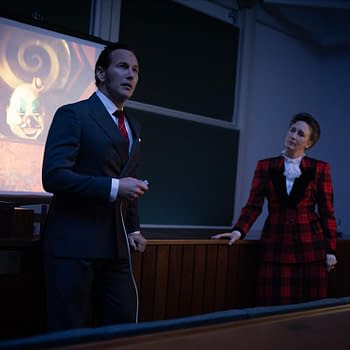Posted in: Movies, Recent Updates, Video Games | Tagged: bioshock infinite, entertainment, Irrational Games, ken levine, retcon, video games
Bioshock: Infinite, Burial At Sea And The Pitfalls Of Retcons – Look! It Moves! By Adi Tantimedh
Adi Tantimedh writes:
Warning: MAJOR SPOILERS. You might want to play through the game before you read this.
The final DLC for Bioshock: Infinite, the second episode of Burial at Sea is a mixed bag with strange meanings and questions, not all of them good.
In fact, a lot of it is bad.
The DLC is not only the final piece of story for Bioshock: Infinite, but also the final piece of a game produced by Ken Levine's studio Irrational Games. For fans, that can be bittersweet or downright sad, especially given how problematic Bioshock: infinite had been, but Burial at Sea Episode 2 is even more problematic.
There's a sense that Levine and the developers wanted to explore some new ideas here: now Elizabeth is the playable character and she can depend on stealth with the use of a crossbow as a callback to the original PC version of Thief that Levine had worked on. There's nothing wrong with the gameplay design as it plays on variations on the formula established back in the first Bioshock game, but it's the story that I have a problem with.
Burial at Sea Episode 2 was pitched as the ending of the story that began in Bioshock: Infinite. It brings heroine Elizabeth to the libertarian underwater city of Rapture on a mission to rescue a Little Sister named Sally. Feeling guilt for using Sally as bait back in Episode 1 to lure the last remaining Comstock in the multiverse to his doom, Elizabeth now feels obligated to save Sally from her fate as a Little Sister. However, she's at a distinct disadvantage: where she had been virtually omniscient by the end of Infinite and Episode 1, she's now been left without her powers of omniscience and is utterly vulnerable to the homicidal psychos that stalk Rapture.
She also finds that this is not her first attempt to save Sally. In her previous attempts, she died. And the last remaining Elizabeth, who shared her omniscience and guilt, has asked the quantum-entangled scientists The Lutece Twins to bring her to Rapture for one last try. She has lost her ability to see all pasts, presents and futures, but knows deep down why she has to keep trying. There's a future she had already seen that she needs to bring forth, but can't remember what it is. Only the voice of the late Booker DeWitt, her father and only friend, keeps her going, and he's an expression of her subconscious.
Confused? Don't worry, it's not your fault. If this all sounds like fanservice bollocks covered up by Quantum mechanics, it is. This made me think about the problem with retcons and fanservice, when a follow-up story does not cast any real new insight or light on the story but also dilutes the emotional and thematic impact of the original story. The DLC story is intended to bridge the gap between the original Bioshock and Bioshock: Infinite, "revealing" various links between the two stories and universes where it turns out that it is the interdimensional tears from Infinite that enable the creation of the Big Daddies in Rapture and that characters from both universes had met before. None of these revelations really add anything to our understanding of the original plots of the two games.
Retcons are an increasingly bad habit that writers develop to try to smooth over past mistakes and inconsistencies. DC and Marvel Comics have done this for decades, and here Ken Levine has tried to do that with a result that doesn't wash. In Infinite, the revolutionary leader Daisy Fitzroy led a violent rebellion of the exploited black and Irish working class against the rich of the city of Columbia, and her followers rampaged through the city murdering and scalping the citizens in acts of wanton revenge that some commentators had accused the story of unearned cynicism and equivalency. Daisy Fitzroy herself, who had been shown as intelligent and articulate in audio recordings from her past, not only murdered the callous industrialist Jeremiah Finke, but also tried to kill his young son. This led many critics to accuse the story of racism and misogyny.
In Burial at Sea Episode 2, Daisy's attempt to kill Finke's son is revealed as a ruse to manipulate Elizabeth into killing her so that the latter could become hardened enough to confront and defeat the despotic Comstock. Daisy agreed to die because she was shown that she would not live to see her revolution succeed, so dying here would at least let her achieve martyrdom. Now, this bit of retconning smacks of backtracking bullshit, that Levine might have realized his mistake in portraying Daisy Fitzroy as a bloodthirsty maniac in Infinite and was attempting to correct it. Unfortunately, this corrective feels every bit as hamfisted and cynical as the original story.
Here's another detail in Episode 2 I'm confused about: why does Levine have Elizabeth get hit in the head with a blunt instrument so many times in the story? She gets hit in the head at least six times. That's probably the most times a protagonist has ever been hit in the head in a single video game, novel or movie. By rights, by the second or third time, she would have ended up with serious concussion and probably be in a coma with possible brain damage. I know that the hero getting knocked out is a convention in noir stories, but six times?! Sometimes I think writers who take their influence from other genre stories may be too unaware of the true realities of injuries like gunshot wounds and head trauma… yeah, this is a game where people can shoot elemental powers out of their hands and there's a Randian city built under the sea, but still…
The rest of the plot is about how Elizabeth's actions actually result in Jack, the main character of the first Bioshock, arriving in the city to defeat the killers and would-be despots and rescue Sally and the rest of the Little Sisters, which Elizabeth knew she would not be able to do. She realizes that her own rescue mission was not going to succeed and she would not leave the city alive. She accepts this as her penance for the deaths she's responsible for in Bioshock: Infinite and her act of murder in Burial at Sea Episode 1, and a way to finally release herself from her cursed life. It brings the story of Infinite and the first game together in full circle. Some players find this degree of meta fun and exhilarating. I don't. Elizabeth's tragedy is meant to be epic and bathetic, but I find it convoluted unearned.
Bioshock: Infinite introduced this powerful heroine who's beloved by fans. Burial at Sea Episode 2 takes away her power and ends her story by having her get beaten to death by a man.
I find that troubling, as I do Levine's consistent theme throughout the series that the only way to achieve redemption from a life of violence and complicity with brutality is through sacrifice and death. There's an over-determined moralism in Levine's writing in the games that feels claustrophobic. You can also read another subtext in Episode 2 when it was announced that this was the end of the story begun in Infinite and also the first game. Where Infinite ended on a note of infinite possibilities in its revelation of the story existing in a multiverse and Elizabeth as its avatar, Episode 2 retcons and reverses that sense of openness and infinite possibilities by killing her off and tying off the stories of both Infinite and the first game. It was as if this was Ken Levine's way of ensuring any attempts by 2K, the publisher of the games and owners of Irrational Studios, to make more Bioshock games after him would be doomed to artistic failure.
The end of the Bioshock under the authorship of Ken Levine and the closure of Irrational might also be indicative of an underlying crisis in the making of AAA games. Bioshock: Infinite had been in development for so many years, with many ideas and designs prototyped then scrapped with so much money spent that it didn't make enough of a profit in sales. Many critics had expressed disappointment in the game when it was finally released – the new design ideas and innovations in interactivity initially promised when the game was first publicly announced were largely absent and too much of the gameplay was considered run-of-the-mill and mediocre by players, despite mostly rave reviews. The game was going to have to sell in numbers approaching that of Grand Theft Auto V and that was never going to happen.
While its budget and sales figures have never been publicly disclosed, there are indications that Infinite has not sold in sufficient numbers to make back its production budget, which must be a factor in Irrational being shut down and Levine declaring a scaling-down to a smaller team for his new studio. It's possible that the disappointment and exhaustion of the impending closure has effected the writing of Burial at Sea Episode 2 and whatever more interesting original plans were scrapped in favour of what ended up in the final product. What we're left with is a sense of disappointment, despair and anticlimax.
No alternate realities at lookitmoves@gmail.com
Follow the official LOOK! IT MOVES! twitter feed at http://twitter.com/lookitmoves for thoughts and snark on media and pop culture, stuff for future columns and stuff I may never spend a whole column writing about.
Look! It Moves! © Adisakdi Tantimedh




















